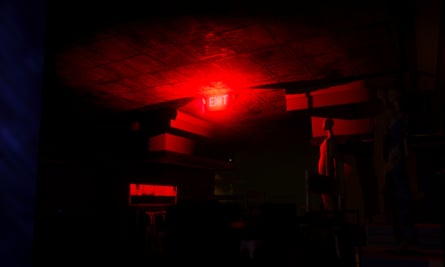L
As I look back at the history of independent video games, I am struck by the prevalence of horror themes. From the shareware era of the 1990s with games like Doom and Hugo’s House of Horrors, to the Flash games of the early 2000s such as Exmortis, the House series, and the now lost Hotel 626, and even into the modern indie age, lone coders and small development studios have consistently explored dark and eerie narratives set in haunted houses, desolate forests, and abandoned spacecrafts filled with demonic beings. Many of the most highly regarded horror games of all time are indie titles, including Amnesia: Dark Descent, Devotion, Slender, and Iron Lung. And let’s not forget about Five Nights at Freddy’s, one of the most successful indie games of the past decade that initially gained popularity through word of mouth.
Independent developers may not have the same level of refinement or recognition as franchises like Resident Evil or Dead Space, but their lesser-known status only enhances the fear and unpredictability they evoke. This begs the question: why is the horror genre so appealing to independent developers? What drives them to create terrifying experiences?
There are of course sound financial reasons. Fledgling studios often use horror in the same way film-makers such as Peter Jackson, Kathryn Bigelow and David Lynch once did – as a means of making impact on a low budget. “There is an element of horror being cheap, with certain approaches,” says Sam Barlow, developer of Telling Lies and Immortality, who cut his teeth as a writer and designer on the Silent Hill series. “It takes about five minutes to load up Unity or Unreal and create a room, add fog and drop in a player with a flashlight. Instant atmosphere! Horror narratives tend to be lonely and you naturally move slowly through them. Some of these affordances are the same reason that film studios make horror movies – the basics don’t cost much but there’s a huge audience who reliably show up.”
Jordan Mochi, creator at Catchweight Studio, is currently working on Conscript, a captivating horror game set during the first world war. The game draws inspiration from historical documents, letters, art, and poems. Mochi acknowledges the advantages of this genre, noting that it allows for a more compact and detailed approach rather than focusing on vast open worlds. He explains, “I’ve always been drawn to the intentional design of classic survival horror games. Every aspect, from camera angles to enemies to puzzles, serves a greater purpose in the story and narrative. Instead of navigating through a sprawling 100km world, players are immersed in a more condensed and atmospheric environment. This level of focus is often lacking in larger titles across different genres.”

The horror genre is a space where unconventional ideas are embraced, making it an appealing option for experimental studios. According to Barlow, many independent developers are drawn to this genre because it allows them to create something personal and outside the mainstream. Unlike mainstream games, which prioritize fun and appeal to a broad audience, horror deliberately aims to make its audience uncomfortable and challenges the notion that entertainment must always be enjoyable. Barlow’s goal is to tell stories that delve into the inner workings of our minds and our subjective perception of reality. What makes horror unique is its ability to bring abstract and intellectual concepts to life in a tangible and visceral way.
Based on the theories of the uncanny by Freud, Lacan, and Julia Kristeva, we feel afraid and repulsed when things that are familiar become strange, such as when we encounter repetitive noises and visual patterns, or when inanimate objects (like dolls, robots, and mannequins) seem alive, or living creatures appear to be objects. As a result, the slightly awkward animations, technical glitches, and limited visibility often found in indie horror games actually add to the overall experience, as they instinctively create a sense of unease through odd movements, expressionless faces, and oppressive darkness.
In the 1990s, the creators of the first survival horror games intelligently took advantage of the limited capabilities of 3D graphics hardware. They utilized a method called “fogging” to intentionally restrict the player’s view distance and reduce processing expenses. This became a common technique in Silent Hill games, where mist would cover each location and conceal the lurking monsters. In today’s gaming landscape, titles like Slender, Phasmophobia, and SOMA also rely on darkness and fog to obscure the game environment and limit the player’s perception of the horrors present.
According to Jaroslav Švelch, an assistant in media studies at Charles University in Prague and author of “Player vs Monster: The Making and Breaking of Video Game Monstrosity,” good horror is often achieved by leaving things to the imagination, making it a suitable approach for low-budget productions. As Lovecraft famously stated, the fear of the unknown is the greatest fear. Adding more visual detail and realism can actually limit the unknown, making it less frightening. In contrast, a monster with vague features, like Grue in Zork, can maintain a sense of mystery.
The feeling of the uncanny can also arise when we come across childhood beliefs, possessions, or experiences as adults and perceive them as eerie and deteriorated. An ancestral house that now stands abandoned and decaying; a beloved china doll now worn and eerily staring – these are common elements in horror literature, films, and games that transform nostalgia into fear. According to Joe Henson, co-creator of the upcoming horror game Don’t Scream which utilizes Unreal Engine 5, the use of PlayStation-like graphics in many independent horror titles is a testament to how undefined visuals can intensify the sense of fear. The lack of detail leaves room for our imagination to run wild and also evokes a sense of nostalgia, especially with the use of found footage and VHS visuals.
The manipulation of our fondness for past games and platforms has become a common element in horror games. These games utilize pixelated graphics and nostalgic themes to attract unsuspecting players, and a group of independent developers known as Haunted PS1 specializes in creating games that resemble those from the PlayStation era. According to Švelch, “Retro genres and aesthetics often evoke a sense of comfort, but indie horror games tend to distort and subvert them, producing an eerie and disorienting effect.” One notable example is Doki Doki Literature Club, which initially presents as a typical visual novel but gradually transforms into a glitch-filled tale of existential horror.
Nina Freeman, a game developer, believes that old-school horror has greatly influenced contemporary game creators. She explains, “Many developers in my generation, who were kids in the 90s, grew up playing iconic horror games during crucial stages of their development. Games like Silent Hill, Fatal Frame, and Resident Evil have had a significant impact on the individuals who are now working as developers in both independent and big-budget companies.”
Ignore the promotion for the newsletter.
after newsletter promotion
Freeman is also a content creator who streams live videos. Her engaging and enlightening walkthroughs of classic horror games showcase another valuable aspect of these types of games: they are enjoyable to watch. Sharing the experience and seeing someone else react with jumps and screams can be therapeutic, making horror games a popular choice for streamers and video creators who do “let’s play” videos. As a result, independent titles like Five Nights at Freddy’s and Phasmophobia have gained immense viral success. Horror game developers now consider streamers when starting new projects. The upcoming game Don’t Scream requires players to wear a microphone while navigating a haunted forest – if they scream or gasp in shock, the game ends. This concept is specifically designed for streamers to create engaging content.

There are strong connections between horror and small-scale development. Horror revolves around feelings of vulnerability and helplessness, making indie games the perfect platform to explore this theme. Developer and writer Jim Rossignol explains, “Bigger games tend to focus on power fantasies, such as stomping on horrors in Dead Space. However, indies are more comfortable with portraying disempowerment and vulnerability. The most successful horror experiences often leave players feeling extremely vulnerable, and creating systems that convey this effectively is a challenging and exploratory task that indies are well-suited for.”
In the independent game community, it is common to create highly personal and subjective games. These games often tell stories about the creator and can touch on dark themes. Freeman, currently working on a game called Size Zero, explains that she is drawn to horror as a means of exploring challenging topics and societal issues. As the industry becomes more inclusive and diverse, it is likely that more creators will want to delve into these difficult narratives.
Creating artwork that delves into personal and real traumas can be intimidating and draining. Horror provides tropes and tools that act as a shield, allowing us to distance ourselves from our own experiences and the horrors depicted in the story. This can be a beneficial and thought-provoking approach to addressing difficult topics that we may otherwise avoid.

The horror genre delves into societal fears beyond traditional elements like ghosts and gore. Movies in the 1950s, for example, used giant monsters to explore the fear of nuclear warfare. Similarly, slasher films in the 70s and 80s tackled gender issues. Now, with the rise of technology and artificial intelligence, games like Signalis, Soma, and Observer are addressing our anxieties in this area. These themes may be avoided or turned into action-packed games by large development teams with significant budgets. However, in the independent sector, they can truly evoke terror. Mochi, the developer of Conscript, explains that indie developers are the ones taking risks. They are more likely to create experimental games such as a survival horror set in World War I, as these ideas may not be approved by larger AAA companies. This type of bold and unique content is mainly seen in the indie space.
Source: theguardian.com


